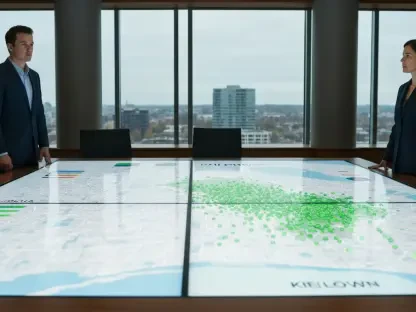In an era where sustainability is no longer optional but a critical imperative, the role of landscape architecture in shaping outdoor spaces has taken on unprecedented importance, driven by the pressing need to meet Environmental, Social, and Governance (ESG) targets. Once relegated to the sidelines as a mere aesthetic addition to development projects, thoughtfully designed landscapes are now central to creating environments that balance ecological responsibility with human well-being. This shift is not just a trend but a fundamental reimagining of how built spaces interact with nature and communities. As developers face mounting pressure to align with stringent sustainability goals, landscape architects are stepping into the spotlight as key players in crafting outdoor areas that enhance biodiversity, support mental health, and boost commercial value. Drawing on insights from industry leaders like Emma McNicholas, a director at a prominent landscape architecture firm, this exploration delves into how ESG priorities are redefining the purpose and impact of green spaces in modern development.
The Growing Influence of ESG on Development Priorities
The integration of ESG targets into business strategies has become a defining factor for industries worldwide, particularly in construction and urban planning, where the stakes for environmental and social impact are high. Landscape architecture has emerged as a linchpin in this transformation, offering solutions that help developers meet ambitious sustainability goals while creating spaces that resonate with community needs. Certifications such as Fitwel and BREEAM, which set benchmarks for health-focused and eco-friendly design, often depend on the inclusion of well-planned outdoor areas. These spaces are no longer just patches of greenery but strategic assets that reduce carbon footprints, manage stormwater, and foster biodiversity. By embedding these elements into project blueprints, developers can achieve compliance with regulatory standards while enhancing the overall appeal of their properties, proving that sustainability and profitability can go hand in hand in today’s market.
Beyond certifications, the influence of ESG targets is reshaping how outdoor spaces are perceived within the broader scope of development. Developers now recognize that green areas contribute significantly to meeting both environmental mandates and social expectations, creating a ripple effect on project planning. High-quality landscapes are increasingly seen as a means to elevate property values, attract tenants, and secure long-term returns on investment. This evolving perspective underscores a broader cultural shift toward valuing nature as an integral part of urban and rural environments. Landscape architects, tasked with translating these priorities into tangible designs, are becoming indispensable partners in ensuring that projects not only adhere to strict guidelines but also deliver meaningful benefits to the public. As a result, the industry is witnessing a redefinition of what constitutes a successful development, with outdoor spaces playing a pivotal role in achieving holistic outcomes.
Changing Attitudes Toward Outdoor Environments
A profound change in how outdoor spaces are valued has taken root in recent years, particularly following global events that highlighted the necessity of accessible natural areas for personal well-being. Post-pandemic, the importance of green spaces for mental and physical health has become undeniable, prompting a shift away from viewing landscapes as mere decorative features. Biophilic design, which seeks to connect people with nature through intentional elements like green walls and urban forests, is now a cornerstone of modern planning. Developers are prioritizing these features to create environments that offer respite and foster a sense of community, recognizing that such spaces can significantly enhance the quality of life for residents and workers alike. This newfound appreciation is driving demand for landscapes that serve as functional, health-promoting areas rather than just visual enhancements.
This evolving mindset is reflected across diverse projects, from sprawling rural developments to dense urban centers, where the inclusion of communal green areas and innovative streetscapes is becoming standard practice. The emphasis on outdoor spaces aligns directly with the social and environmental pillars of ESG frameworks, as these areas provide measurable benefits like improved air quality and opportunities for social interaction. For instance, thoughtfully designed parks and public plazas are not just amenities but vital components that shape how individuals engage with their surroundings. This shift in perception has elevated landscape architecture to a critical discipline, ensuring that outdoor environments are integrated into the core vision of development rather than treated as an afterthought. As a result, the industry is adapting to meet these expectations, placing greater emphasis on creating spaces that resonate on both a practical and emotional level with those who inhabit them.
Sustainability as the Core of Modern Landscape Practices
At the heart of contemporary landscape architecture lies a deep commitment to sustainability, reflecting an industry-wide pivot toward environmentally responsible practices that meet the demands of ESG targets. Leading firms have long embraced this ethos, blending aesthetic innovation with technical precision to deliver projects that minimize ecological harm. Tools like Building Information Modeling (BIM) and advanced software enable architects to design with accuracy, ensuring that landscapes contribute to goals like carbon reduction and resource efficiency. This focus on sustainability is not merely a response to market trends but a fundamental principle, as seen in efforts to address challenges like soil remediation on brownfield sites and the integration of native plant species to support local ecosystems. Such practices demonstrate that beautiful design and environmental stewardship can coexist seamlessly.
Further driving this sustainable approach are regulatory frameworks that emphasize health and social outcomes as much as environmental impact. Policies like Scotland’s National Planning Framework (NPF) 4 are setting the stage for landscape designs that prioritize community benefits alongside ecological goals. Architects are tasked with navigating complex site-specific issues, such as harsh weather conditions or degraded land, while creating spaces that bolster resilience against climate change. This dual focus requires a balance of creativity and technical expertise, ensuring that landscapes not only serve immediate needs but also contribute to long-term planetary health. By embedding sustainability into every facet of their work, landscape architects are helping to shape a future where outdoor spaces act as catalysts for positive change, aligning development with the urgent need to protect and restore natural systems for generations to come.
Bridging Health, Community, and Environmental Goals
The intersection of health, community engagement, and environmental stewardship is where landscape architecture truly shines as a transformative force under ESG mandates. Studies consistently show that access to green spaces can prevent illness, reduce stress, and improve overall mental health, making them indispensable in urban and suburban planning. Projects that incorporate features like playgrounds, walking trails, and public art not only enhance aesthetic appeal but also create inclusive environments where people can connect and thrive. These elements align with the social pillar of ESG, ensuring that developments contribute positively to the fabric of local communities. Landscape architects are increasingly designing with these outcomes in mind, crafting outdoor areas that serve as communal hubs while addressing broader societal needs.
On the environmental front, the impact of well-designed landscapes extends far beyond surface-level beauty, offering tangible benefits that support ESG objectives. Strategic plantings, water management systems, and habitat creation are just a few ways these spaces mitigate climate challenges and promote biodiversity. For example, projects on challenging sites often require innovative solutions to transform degraded land into vibrant ecosystems, demonstrating the profession’s capacity to turn obstacles into opportunities. This holistic approach ensures that outdoor spaces are not only functional for human use but also restorative for the planet. As developers and planners continue to prioritize these dual benefits, landscape architecture stands out as a discipline capable of bridging the gap between individual well-being and global environmental goals, reshaping how communities interact with their natural surroundings.
Looking Back to Shape Tomorrow’s Landscapes
Reflecting on the journey of landscape architecture, it’s clear that the field has adapted remarkably to the rising demands of ESG targets over recent years, carving out a central role in development. Projects tackled during this period, from expansive rural communities to urban green oases, showcased how outdoor spaces could balance sustainability with social impact. Challenges like skills shortages and site-specific hurdles were met with innovation, as architects employed advanced tools and collaborative strategies to deliver meaningful results. This era of transformation highlighted the profession’s ability to evolve, ensuring that landscapes became more than just add-ons but vital components of a healthier, more connected world.
Moving forward, the focus should be on expanding the talent pipeline through education and outreach, ensuring the industry can sustain its momentum. Developers must continue to involve landscape architects early in the planning process to maximize the potential of outdoor spaces. Additionally, embracing emerging technologies and interdisciplinary approaches will be key to addressing future environmental challenges. By building on past successes, the field can drive even greater impact, creating landscapes that not only meet today’s needs but also anticipate tomorrow’s demands, fostering environments where both people and nature can flourish.









